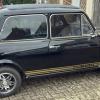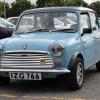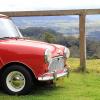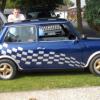Rear Wheel Bearing
#1

Posted Yesterday, 08:19 PM
Thought I'd have a better look today.
Anyways I rocked the rear off the car side to side whilst it was sat on the floor and could hear a knock from the OSR wheel. Sounded like loose wheel nuts. So I jacked up that wheel and it had some play in it.
Removed the hub and cleaned everything up. Bearings are timken taper type. I greased it all up and tightened everything up but the knocking is still there, but not as bad.
I'm obviously going to order a new wheel bearing kit to replace this one.
I looked up the hubnut torque setting, some say 60lbft and some say just do it up until there's no play and on another site I read to do the taper type up really tight.
Can anyone confirm the torque setting please? Thanks
#2

Posted Yesterday, 09:57 PM
The factory stated torque for this nut is 60 lb/ft, then on to the next slot for the split pin.
Have a good look inside the hub where the bearings fit, they can wear / distort making it feel like a worn bearing. usually a worn bearing will have a rumbling sound as you drive.
#3

Posted Yesterday, 10:36 PM
The normal technique I employ when setting any single adjusting nut design of taper roller bearings that are properly fitted and lubricated invloves tightening the adjusting nut whilst rotating the hub until a slight drag is felt, then backing off the nut to the nearest locking hole or sufficiently to allow the hub to rotate freely with minimum end play.
The adjusting nut is then locked in this possition, the skill involved is in the judgement of determining when the hub binds slightly on rotation.
No more complicated than that.
I find that if adjusted in this manner the correct bearing preload is set and the bearing end float is correct.
If any "play" still exists then look to the hub itself or the bearing stub axle for wear.
Remember too high a preload is as bad as too little.
My method, others may disagree.
#4

Posted Yesterday, 10:57 PM
#5

Posted Today, 12:17 AM
The normal technique I employ when setting any single adjusting nut design of taper roller bearings that are properly fitted and lubricated invloves tightening the adjusting nut whilst rotating the hub until a slight drag is felt, then backing off the nut to the nearest locking hole or sufficiently to allow the hub to rotate freely with minimum end play.
The adjusting nut is then locked in this possition, the skill involved is in the judgement of determining when the hub binds slightly on rotation.
No more complicated than that.
I find that if adjusted in this manner the correct bearing preload is set and the bearing end float is correct.
If any "play" still exists then look to the hub itself or the bearing stub axle for wear.
Remember too high a preload is as bad as too little.
My method, others may disagree.
Thanks for that, while this is how most Taper Wheel Bearings are set on more common cars, Minis - like everything else, are different. I often say to people who have loads of general vehicle experience with spinning spanners to forget everything they know when working on these cars !
The Rear Wheel Bearing assy is different in that it has a spacer that's fitted between the cones of the Bearings as stated by the factory below;-

#6

Posted Today, 05:56 AM
#7

Posted Today, 08:18 AM
Did you check the rear shock absorbers to ensure the top nut is tight?
#8

Posted Today, 08:39 AM
I replaced a wheel bearing chasing a noise that turned out to be a knocking exhaust mount
#9

Posted Today, 09:19 AM
#10

Posted Today, 04:04 PM
I have regressed and torqued up to 60lbft of torque. The castelated nut was in a position that the split pin couldn't go through the hole so I turned the nut tighter until it all lined up. If I remember I think that when the hubs were fitted someone said to tighten to the torque and then back off until the hole for the split pin was aligned. Obviously that was probably OK when the bearing was rammed full of grease etc.
I often wondered why someone said to back it off rather than go to the next hole
#11

Posted Today, 07:26 PM
#12

Posted Today, 07:29 PM
So I could feel play in the wheel when it was jacked up. Now no play in the wheel.
I have regressed and torqued up to 60lbft of torque. The castelated nut was in a position that the split pin couldn't go through the hole so I turned the nut tighter until it all lined up. If I remember I think that when the hubs were fitted someone said to tighten to the torque and then back off until the hole for the split pin was aligned. Obviously that was probably OK when the bearing was rammed full of grease etc.
I often wondered why someone said to back it off rather than go to the next hole
In the factory torque chart I post above, it does stated to tighten to 60 lb/ft, then continue tightening to align the slot to get the slit pin in.
The reality is with the design of these bearings, you'd strip the thread in the nut long before you over tightened the bearing.
#13

Posted Today, 07:45 PM
Can I get bushes or just go for nice pair of new KYB shocks?
#14

Posted Today, 07:59 PM
OK thanks for the brilliant info again spider. Really appreciate your help. On my rear NS shock the lower mount can move side to side a few mm and makes a click sound when it does so.
Can I get bushes or just go for nice pair of new KYB shocks?
Fit new, definitely quicker to fit new than rebush old shock
#15

Posted Today, 08:12 PM
2 user(s) are reading this topic
1 members, 1 guests, 0 anonymous users
-
germini30



















